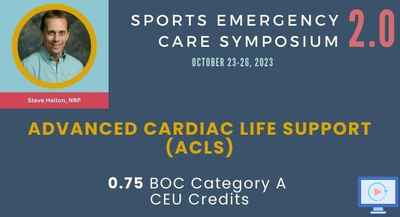Course Info (BOC Domains of Athletic Training; Presentation Description; Learning Objectives; Clinical Practice Gap Statement; Clinical Bottom Line; Summary Conclusions)
BOC Domains of Athletic Training:
-
Domain I - Risk Reduction, Wellness, and Health Literacy
-
Domain II - Clinical Evaluation and Diagnosis
-
Domain Ill - Critical Incident Management
- Domain IV - Therapeutic Interventions
Presentation Description:
This presentation focuses on Advanced Cardiac Life Support (ACLS) for athletic trainers. We'll delve into the intricacies of different cardiac rhythms, discussing assessment and resuscitative techniques tailored to various age groups. Moreover, the audience will gain insights into the assessment and management of post-cardiac-arrest patients and learn how to make informed ACLS decisions in critical scenarios.
Learning Objectives:
- Compare and contrast different cardiac rhythms (VF, VT, asystole, PEA).
- Discuss appropriate assessment and resuscitative techniques for different age groups.
- Identify assessment and management techniques for post-cardiac-arrest patients.
- Make decisions regarding ACLS in cardiac arrest scenarios.
Clinical Practice Gap Statement:
Despite having a foundational understanding of emergency care, many athletic trainers may lack specific expertise in Advanced Cardiac Life Support (ACLS). This shortcoming includes the ability to discern between different cardiac rhythms and the specialized considerations required for different age groups, potentially compromising the effectiveness of life-saving interventions in cardiac emergencies during athletic events.
Clinical Bottom Line Statement:
For athletic trainers, a thorough understanding of ACLS—including the ability to differentiate various cardiac rhythms, adapt resuscitative techniques according to the patient's age, and manage post-cardiac-arrest care—is crucial. Such comprehensive knowledge enables them to make informed, evidence-based decisions, significantly enhancing the quality of emergency cardiac care in athletic settings.
Summary Conclusion Statements:
- Mastery of cardiac rhythms is a cornerstone for effective ACLS interventions.
- Customizing resuscitative strategies based on age is key to elevating the quality of emergency care.
- Being proficient in ACLS guidelines enables athletic trainers to provide superior post-cardiac-arrest management.


